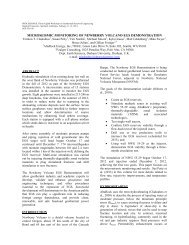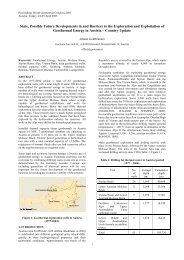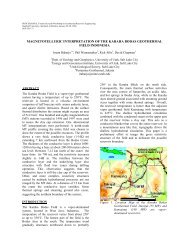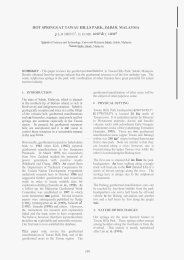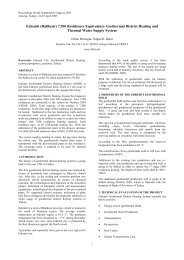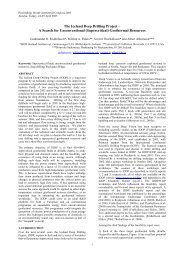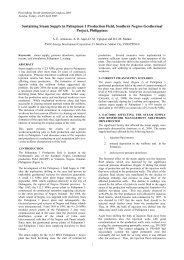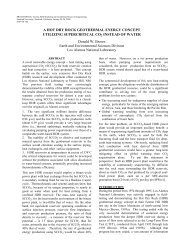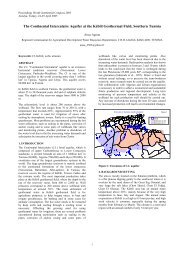Rock Mechanical Testing and Petrologic Analysis in Support of Well ...
Rock Mechanical Testing and Petrologic Analysis in Support of Well ...
Rock Mechanical Testing and Petrologic Analysis in Support of Well ...
You also want an ePaper? Increase the reach of your titles
YUMPU automatically turns print PDFs into web optimized ePapers that Google loves.
3% pyrite <strong>in</strong> the silicified rock. Chemical dissolution<br />
<strong>of</strong> these carbonate-filled ve<strong>in</strong>s could potentially<br />
enhance permeability <strong>in</strong> these relatively tight<br />
siliceous rhyolites (Xu et al, 2009).<br />
Figure 3: XRD m<strong>in</strong>eralogy <strong>of</strong> well cutt<strong>in</strong>gs samples<br />
<strong>in</strong> the proposed stimulation <strong>in</strong>terval <strong>of</strong> <strong>Well</strong> 27-15 (<strong>in</strong><br />
relative weight percent). The contact between<br />
overly<strong>in</strong>g Tertiary rhyolites <strong>and</strong> the metamorphic<br />
basement occurs at a depth <strong>of</strong> approximately 3300 ft.<br />
<strong>Well</strong> 27-15, layers <strong>of</strong> clay alteration along bedd<strong>in</strong>g<br />
planes are easily identified as highly conductive<br />
planar features <strong>in</strong> Formation Microscanner (FMS)<br />
images (Kovac et al., 2009).<br />
The most siliceous rhyolites are comprised <strong>of</strong> 40-<br />
50% quartz, <strong>and</strong> are represented at depths <strong>of</strong> 3100-<br />
3280 ft <strong>in</strong> <strong>Well</strong> 27-15, <strong>and</strong> 2437-2530 ft <strong>in</strong> <strong>Well</strong> 35-<br />
13. In the upper parts <strong>of</strong> these zones, the rocks are<br />
generally dense <strong>and</strong> non-brecciated. With <strong>in</strong>creas<strong>in</strong>g<br />
depth <strong>in</strong> 27-15, the tuffaceous units are more<br />
silicified <strong>and</strong> have f<strong>in</strong>e quartz ve<strong>in</strong>lets that cut across<br />
the rock. In 35-13, most <strong>of</strong> the rhyolite core samples<br />
are densely welded, siliceous tuffs without abundant<br />
ve<strong>in</strong>s; samples ODP4, 5, <strong>and</strong> 9 (2437-2530 ft) are<br />
especially uniform <strong>in</strong> overall texture. XRD analyses<br />
<strong>in</strong>dicate a rather homogenous composition <strong>in</strong> this<br />
<strong>in</strong>terval with 40-43% quartz, 23-31% potassium<br />
feldspar, 8-12% plagioclase, <strong>and</strong> 16-19% clay.<br />
In <strong>Well</strong> 27-15, the base <strong>of</strong> the rhyolite sequence is<br />
highly silicified <strong>and</strong> recrystallized, <strong>and</strong> orig<strong>in</strong>al<br />
tuffaceous textures are generally obscured. The<br />
phyllic hydrothermal alteration assemblage consists<br />
<strong>of</strong> pervasive quartz, potassium feldspar, illite, <strong>and</strong><br />
pyrite. FMS images <strong>in</strong> this well exhibit an absence <strong>of</strong><br />
bedd<strong>in</strong>g planes <strong>in</strong> the 3190-3300 ft <strong>in</strong>terval (Kovac et<br />
al., 2009), but the presence <strong>of</strong> several m<strong>in</strong>or flow<strong>in</strong>g<br />
fractures are identified by temperature <strong>and</strong> sp<strong>in</strong>ner<br />
flowmeter surveys (Davatzes <strong>and</strong> Hickman, 2009).<br />
In th<strong>in</strong> section, thicker (0.5 mm) ve<strong>in</strong>s are filled with<br />
blocky calcite <strong>and</strong> have just a th<strong>in</strong> selvage <strong>of</strong><br />
prismatic quartz crystals. XRD analysis <strong>of</strong> the 27-15<br />
well cutt<strong>in</strong>gs from 3280-3290 ft <strong>in</strong>dicates up to 5%<br />
calcite ve<strong>in</strong>s <strong>and</strong> 2% dolomite alteration, as well as<br />
Basement Lithologies<br />
The upper part <strong>of</strong> the basement with<strong>in</strong> the planned<br />
stimulation <strong>in</strong>terval <strong>of</strong> <strong>Well</strong> 27-15 consists <strong>of</strong><br />
moderately metamorphosed hematitic mudstones<br />
associated with the Jurassic Humboldt Igneous<br />
Complex <strong>and</strong> underly<strong>in</strong>g lower Jurassic <strong>and</strong> upper<br />
Triassic metasediments. In <strong>Well</strong> 35-13, basement<br />
lithologies are more typical <strong>of</strong> the Pre-Tertiary 1<br />
(PT1) package <strong>of</strong> weakly metamorphosed siliceous<br />
shales, dolomudstones <strong>and</strong> metatuffs described from<br />
other wells to the north <strong>and</strong> east <strong>of</strong> the Desert Peak<br />
production area (Lutz et al., 2003; 2004; 2009).<br />
XRD analysis <strong>of</strong> the 35-13 core samples <strong>in</strong>dicates a<br />
fairly uniform m<strong>in</strong>eralogical composition with 42-<br />
55% quartz <strong>and</strong> 28-42% clay <strong>in</strong> illitic/siliceous<br />
metamudstones. The contact between overly<strong>in</strong>g<br />
Tertiary tuffs <strong>and</strong> the metamorphic basement occurs<br />
at about 3300 ft <strong>in</strong> <strong>Well</strong> 27-15, <strong>and</strong> between 2579.8 ft<br />
<strong>and</strong> 2587.0 ft <strong>in</strong> <strong>Well</strong> 35-13.<br />
The top <strong>of</strong> the basement <strong>in</strong> <strong>Well</strong> 27-15 (3320-3350 ft)<br />
consists <strong>of</strong> biotite schist <strong>and</strong> biotite-rich metavolcanic<br />
rocks. The cutt<strong>in</strong>gs are composed <strong>of</strong> large folded<br />
biotite, quartz, <strong>and</strong> plagioclase crystals with<strong>in</strong> a<br />
highly deformed chloritic <strong>and</strong> hematitic matrix. In<br />
XRD (Figure 3), the <strong>in</strong>crease <strong>in</strong> overall chlorite<br />
content (from 1-2% <strong>in</strong> the rhyolite, up to 6-16% <strong>in</strong><br />
deeper samples) is an <strong>in</strong>dication that metamorphic<br />
rocks <strong>in</strong> the basement have been transected by the<br />
well. Iron <strong>and</strong> titanium oxide m<strong>in</strong>eralization consists<br />
<strong>of</strong> magnetite (1%), hematite (2-4%), <strong>and</strong> anatase<br />
(2%).<br />
Below 3360 ft <strong>in</strong> <strong>Well</strong> 27-15, the metamorphic rocks<br />
are less deformed <strong>and</strong> more f<strong>in</strong>e-gra<strong>in</strong>ed <strong>and</strong><br />
siliceous, but are still strongly m<strong>in</strong>eralized with<br />
hematite. Between 3360 ft <strong>and</strong> 3480 ft, the rocks are<br />
fairly massive hematitic mudstones composed <strong>of</strong> 35-<br />
40% quartz, less than 10% feldspar, up to 4%<br />
hematite, 37-50% total clay, <strong>and</strong> with trace amounts<br />
<strong>of</strong> carbonate <strong>and</strong> amphibole m<strong>in</strong>erals. At 3480-3520<br />
ft, the hematitic mudstones exhibit some fault gouge<br />
development <strong>in</strong> the cutt<strong>in</strong>gs, <strong>and</strong> there is a lithologic<br />
change to more siliceous <strong>and</strong> pyritic mudstones<br />
below. These siliceous mudstones are composed <strong>of</strong><br />
up to 50% quartz <strong>and</strong> 34% illitic clay. The cutt<strong>in</strong>g<br />
samples from 3520 to 3600 ft are generally more<br />
foliated than the overly<strong>in</strong>g hematitic mudstones.<br />
Aligned muscovite plates <strong>and</strong> f<strong>in</strong>ely crystall<strong>in</strong>e illite<br />
exhibit weak to moderate foliation <strong>in</strong> these pelitic<br />
rocks.<br />
Thrust faults <strong>and</strong> other Mesozoic-aged faults<br />
complicate the basement stratigraphy. The FMS<br />
images show strong foliation <strong>in</strong> the metamudstones



